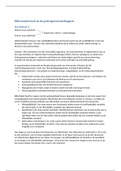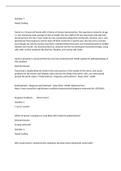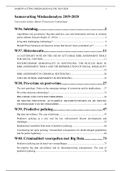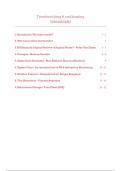● Solution: A molecularly dispersed, homogeneous mixture of two or more
substances (components) consisting of a single phase.
● A special kind of mixture; Molecularly dispersed means that the smallest
particles in the solution are molecules. Homogeneous means the same
throughout, any sample of the solution is the same. A single phase means we
don’t see any division between any parts of the solution (oil and water
is the complete opposite)
● For a mixture to be a solution is must obey all these criteria
● The smallest molecule in the solution becomes a molecule of water
and sugar, that is how it dissolves.
As particles increase in size it goes from a true solution to a colloidal solution to suspensions.
● Colloidal solutions: A mixture in which the dispersed particles are larger in size than the
true solution size. Proteins in water will give you a colloid.
● Tyndall effect: Tyndall effect, also called Tyndall phenomenon, scattering of a
beam of light by a medium containing small suspended particles—e.g.,
smoke or dust in a room, which makes visible a light beam entering a window.
● One phase: no separation between the substances
● Emulsion: There are two phases in the substance. Ex: the picture is globules of fat
dispersed in water.
BINARY SOLUTIONS:
● A solution made up of two components: Solvent (major) and Solute (minor)
● If the two are liquids, it doesn’t mean very much. It is more meaningful when they are of
different states of matter.
● Solutions can be solid, liquid, or gas. Aqueous solutions, where water is the solvent, are
the most important solutions.
● MULTI COMPONENT SOLUTIONS: solutions
with more than two substances
● TERNARY : 3 components
● QUATERNARY : 4 components
, TYPES OF SOLUTIONS:
● Dilute
● Concentrated
● Saturated
● Unsaturated
● Supersaturated
● Concentrated: solution with large amount of solute
● Dilute: solution with small amount of solute
Note: Solute is what is being dissolved. Here, the darker one is the most concentrated
because it has the most color and the color is the solute. It is being dissolved in the water
● Unsaturated: More room for dissolvement
● Saturated: No more can be dissolved (It has reached the saturation point)
● Supersaturated: More is dissolved than the solution would normally be able to
Ex: start with water and copper II Sulfate, which is a blue color.
Based on how much you put in, you can either dissolve more or
less. If you add only one scoop, you can add more because there
is more room for dissolvement. That is when it is unsaturated.
When it comes to a point when the solute will not dissolve
anymore, aka it goes to the bottom and no matter how much you
mix it will not dissolve we say the liquid is saturated.
If we increase the temperature of a saturated solution, we turn it
back into an unsaturated solution because more can dissolve now that there is more heat.
If you cool the beaker back to make it saturated again, but do this very carefully, you can
end up with the same amount of grams dissolved (the original plus what you added when
you heated the beaker) but at the same temperature as the original unsaturated solution.
However, this is not in equilibrium. If anything happens to the beaker, it will go back to
its saturated state.
● Refer to supersaturated: The supersaturated
solution is in unstable equilibrium. Also note, the
unsaturated solution and supersaturated solution
look exactly the same, they are only different
because of the history of how they are made. You
cannot tell the difference by only looking at them.
,● Miscible: How mixable something is (how soluble is one liquid in the other)
● Immiscible: How unmixable something is (how insoluble is one liquid in the other) The
two don’t mix.
SOLUBILITY:
● A quantitative description of how soluble a substance is in
another
● The graph shows the different solubilities of different solids at
different temperatures
● At what temperature is potassium chloride more soluble than
sodium chloride? Above 30, potassium chloride becomes more
soluble. For solids, as the temperature increases, the solubility
increases.
● Gasses behave oppositely
● The solubility of the gasses decreases with an increase in
temperature.
● When we boil water, we see bubbles. These are air bubbles that
are coming out of the solution because the amount of solute is decreasing with an
increase in temperature.
SOLUTION CONCENTRATION:
● Mass percent: The mass of what you are looking at divided by the total mass.
● Molar concentration (C): moles of solute in a liter of solution (mol/L)
● Molal concentration: Moles of solute in a Kg of solvent (mol / kg)
● Mole fraction: Number of moles of solute divided by the total number of moles. Or,
amount of solute divided by total amount of solution.
, ● These units are important when looking at the properties of certain solutions
● Note: All volume changes when temperature changes. So, Molar concentration changes
with temperature. To see how something changes with temperature use molar
concentration because none of the others will vary with a change in temperature.
Exercise 1 : We are given the
fraction of grams of solute over
mL of solvent. Switch to moles
per Kg
DILUTION:
If you want to make a very dilute solution of something, you do successive
solutions. Take the full-strength stock solution, dilute it 10 times and take 1mL
of that solution and put it in the other and do that repetitively, so every time, the
solution is being diluted by 10.
THE COLLIGATIVE PROPERTIES:
● There are four interrelated properties of solutions known historically as
colligative properties. These properties depend solely on the nature of the
solvent and the number of solute particles (which is the same thing as the
number of moles)
● NON ELECTROLYTES VS ELECTROLYTES : A solute could either be electrolytes
or nonelectrolytes. Non electrolytes are simpler because one mole of substances yields
one mole of product.
FOUR PROPERTIES :
1. Vapor pressure lowering
2. Boiling point elevation
3. Freezing point depression
4. Osmotic pressure
5.
6. Vapor Pressure:
When the rate of evaporation is very high, the rate of condensation is low.
The pressure exerted by the vapor at a certain temperature under these conditions is called the
vapor pressure.
*Nonvolatile: very low tendency to evaporate










